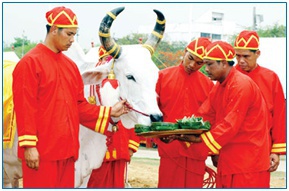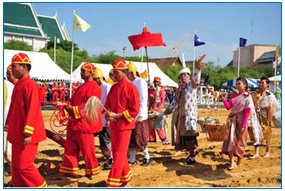|

|

|
The Royal Ploughing Ceremony is an ancient royal rite held at the beginning of the rainy season to mark the traditional, auspicious beginning of the rice-growing season. It is an annual ceremony presided over by their Majesties the King and the Queen, and takes place at Sanam Luang (or the Royal Grounds) near the Grand Palace in Bangkok.
The date is usually during the month of May, but varies as the auspicious date and time are determined by the royal Brahmin astrologers, the ceremony being rooted in Brahmin belief and performed since ancient times. In Thailand, the rite dates back to the Sukhothai Period (1238 – 1438). Throughout the times, the reigning king presided over the ceremony; sometimes he himself even took part and actually guided the plough behind the oxen. Rice farming has always been the major source of food in the country. So since 1966 the Ploughing Ceremony Day has been declared a national holiday and observed as Farmer’s Day as well. Farmers are encouraged to take part in this Ploughing Ceremony.
Nowadays H.M. the King would appoint the Ploughing Lord or Phraya Raekna, a respectable high-ranking government officer, as his representative to perform the rites and rituals. The roles of the Queen or wives having to help ploughing are designated to four celestial maidens, called the queens of the sowing ceremony, assisting Phraya Raekna by carrying rice grain baskets and sowing the grains (grown on the King’s Residence Chitralada Palace grounds), after Phraya Raekna has ploughed the ceremonial grounds, using a sacred wooden plough with a pair of sacred oxen hitched up to it. Walking alongside Phraya Raekna are Brahmins who chant some sacred words and blow conch shells, to ensure a fruitful harvest.
During the ceremony, the amount of rainfall in the coming rainy season is forecast by the royal astrologers, and done through a traditional method. Then the two oxen are offered plates of food, including rice, corn, green beans, sesame, fresh-cut grass, water and rice whisky. Depending on what the oxen eat and drink, a prediction can be made as to whether the coming season’s harvest will be bountiful or not.
After the ceremony ends, the onlookers swarm the field to collect the grains, believed to be auspicious. The farmers will mix the grains with their own rice stock as good luck charms.
The annual Royal Ploughing Ceremony is also an occasion when H.M. the King graciously presents awards and certificates to outstanding farmers from each region, whose fields produced the highest yields during the previous year.
